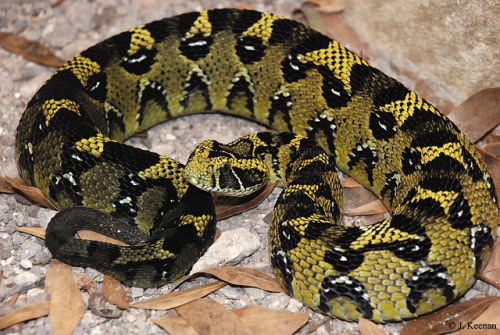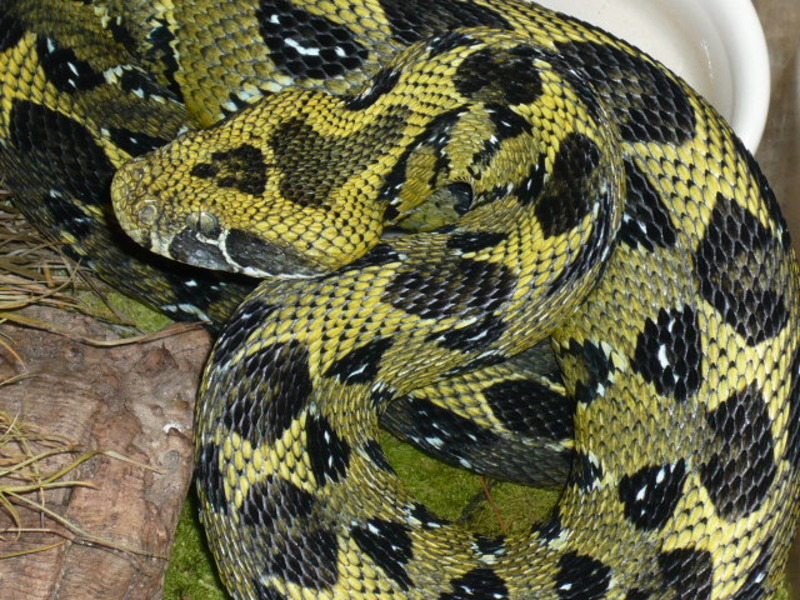Bitis parviocula
The Ethiopian puff adder ( Bitis parviocula ) is a species of snake in the family of vipers. The species was described in 1977 by Wolfgang Böhme scientifically. Overall, only three scientifically documented finds of the kind are. Over the life of this snake is correspondingly little known.
Features
The longest known specimen of the Ethiopian Puff Adder was the type specimen with a length of 75.2 cm, a maximum length of about one meter is assumed. The body is, as is typical for puff adders, relatively bulky and cylindrical, the tail is short. In the middle of the body, the snake has 37 to 39 scale rows around the body, where the scales are clearly keeled. The basic coloration of the body is light to dark brown, green brown on the flanks. About the back is a chain of black, hexagonal back spots ( diamonds) that are partially surrounded by bright scales. Between the black diamonds are butterfly-shaped yellow drawings. The body sides are drawn in the upper area with a row of black triangles with white center and in the lower area with green-gray and mostly limited yellow triangles. The belly is gray-green and may have a dark mottling. It consists of about 144 abdominal plates ( Ventralia ) and are followed by an undivided anal shield and 21 paired Subcaudalia.
The body of the remote, relatively small head is long and flattened and has a basic triangular shape. He is brown in color with a dark, triangular drawing with the widest point between the eyes, this is followed by a bright line separated a light brown, club- shaped drawing item. The head sides each have a dark brown triangle below the eyes ( subocular ) and one of the eyes to the rear end of the mouth gap Gradient ( Temporaldreieck ), which are separated by a thin light strip that runs from the back of the eye edge to the white upper lip. The chin and throat are white with black speckles. The eyes are rather small and sideways, they are surrounded by an eye- ring of 14 individual scales. The iris is dark brown, the pupil is made elliptical and vertically. There are 3 rows of scales between the eye ring and the upper lip shields ( supralabials ). The top of the mouth gap line 13-14 supralabials, the lower edge 15 Sublabialia.
The nostrils are different from other Bitis species of small slots, while about as long as the eye diameter. The entire head is covered with small, keeled scales that form between the eyes ( intraorbital ) 12 rows.
The Ethiopian puff adder differs from the non-indigenous in Ethiopia Gabon Viper ( Bitis gabonica ) by the lack of snout or nose croissant. From the puff adder (B. arietans ) it can be distinguished by the coloration that comes close to the rhinoceros viper (B. nasicornis ). Own, characterizing as a separate type, features are the small eyes, the slit-like nostrils, and the relatively short fangs.
Occurrence and habitat
The snake is only from three localities in southern Ethiopia from altitudes between 2,000 and 3,000 meters known, one assumes, however from a larger distribution area in the mountains. It was described on the basis of a specimen, which was collected in 1975 at the Doki River near the village of Yambo in the previous Illubabor province, today Oromia Region, Ethiopia as roadkill.
Two of the three known copies were in wooded areas and a prisoner in the grasslands near a rocky stream. The type specimen was living in an old coffee plantation. The author Boehme holds in his 1977 published description of the snake an underground lifestyle possible and is based on the basis of description of locals who communicated to him by the collector, from an endemic in the forested areas of the highland mountains of Ethiopia kind.
Way of life
The life of the Ethiopian puff adder is completely unknown. It can be assumed that they, like other Puffottern nocturnal and lives exclusively on the ground. In the first description a frequent stay in underground rodent burrows is believed to an almost exclusively subterranean lifestyle due to the head shape and proportions as well as the relatively short fangs and lack of muzzle croissant. The short fangs - in comparison to other Bitis species of the same size about half as long - allow a bite without having to open the mouth too far. As food would accordingly especially underground living small mammals in question.
Since nothing about the reproduction is also known, is in analogy with the related species on the assumption that the snake bears live young.
Taxonomy
The Ethiopian puff adder is placed in the subgenus Macrocerastes together with the Gaboon Viper ( Bitis gabonica ) and the rhinoceros viper ( Bitis nasicornis ) within the genus Bitis. It is larger and usually plump built puff adders, which are distinguished mainly by the formation of the head shields. The nasal is separated by at least four scales from the first Supralabiale and by three or five scales of the rostral with them. In addition, all of these types have a triangular head and a pair of horn similar enlarged scales on the tip of the snout, but these are reduced in the Ethiopian puff adder. All three species are forest dwellers, their form rich coloration is camouflage on the forest floor.
Snake venom
The composition and activity of the toxin is not known, it has previously been no known case of a bite. It assumes, however, that some Puffotterbisse in southern Ethiopia go back in this way. From the local population it is classified as their relatives to be dangerous; Boehme quoted the collector of the snake so "that the locals had told many times before in the forest areas between Jimma, Bonga and Gore by a thick, short, very venomous snake in the coffee plantation ." In the forested areas the usual puff adder does not occur, so the Ethiopian puff adder must be meant.










